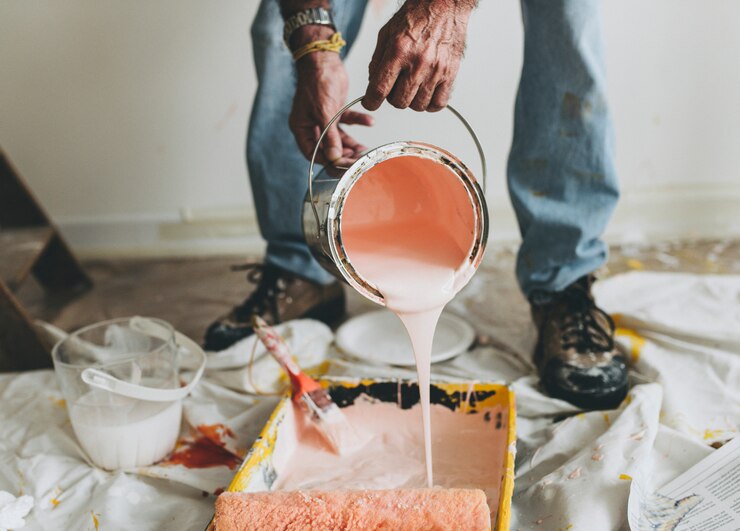Colour is an integral element of our daily lives, influencing our mood, perception, and ultimately, our well-being. When it comes to interior painting, understanding colour psychology’s transformative power can guide your choices and assist you in creating spaces that evoke desired emotions, complement your design aesthetics, and align with your unique lifestyle. As a full-service interior and exterior painting company, we are dedicated to helping our clients navigate the fascinating realm of colour psychology, blending expert guidance and professional workmanship to create visually stunning and emotionally inviting living environments.
In this insightful article, we discuss the fundamentals of colour psychology and the ways specific hues can shape the atmosphere and emotional experience of a space. We will explore how you can use colour to evoke peace and tranquility in a bedroom, foster creativity and collaboration in a home office, or promote a warm, welcoming ambiance in your living room. Our goal is to equip you with the knowledge and inspiration to make informed decisions about your next interior painting project, allowing you to create environments that truly resonate with your personality and vision.
1. Warm and Cool Colours: Balancing Energies in Your Living Space
Understanding the difference between warm and cool colours is crucial when selecting paint shades for your home. Warm colours are reminiscent of sunlight and fire, evoking feelings of warmth, comfort, and energy. In contrast, cool colours are associated with water and sky, often giving a sense of calmness, tranquility, and relaxation. Here’s how to effectively use warm and cool colours in your interior painting project:
– Create Harmony: Combining warm and cool colours in your home can produce a well-balanced living environment that offers both comfort and relaxation. Incorporate these complementary tones to strike the perfect balance of energy and tranquility.
– Accentuate Features: Use warm or cool shades to accent a specific area of a room, such as an accent wall or architectural feature, to draw attention and create visual interest.
– Experiment with Tonal Shifts: Explore subtle variations in tone to craft a seamless transition between rooms and create a cohesive, visually pleasing flow throughout your home.
2. Invoking Emotions with Primary Colours
Primary colours—red, blue, and yellow—have their unique psychological effects and can provide a solid foundation for your interior painting decisions. Consider the following influences when selecting primary colours for your home:
– Red: Known to excite the senses and stimulate appetite, red can be an excellent choice for dining rooms or kitchens. However, use red judiciously, as it can evoke feelings of aggression or anxiety if overused.
– Blue: Blue is often associated with tranquility, stability, and trust, making it an ideal choice for bedrooms and bathrooms. Opt for lighter shades, as darker tones might create an overly somber atmosphere.
– Yellow: This cheerful hue represents happiness, optimism, and creativity. While perfect for nurseries and playrooms, overusing yellow can cause feelings of frustration or agitation, so moderation is crucial.
3. Exploring the Effects of Secondary Colours
Secondary colours—purple, green, and orange—have equally impactful psychological effects. When deciding on paint colours for your home, take note of these unique influences:
– Purple: Often linked with spirituality, creativity, and luxury, purple can be an excellent choice for meditation spaces, home offices, or living rooms. Lavender shades have a soothing effect, while darker tones exude elegance and sophistication.
– Green: A symbol of nature, growth, and renewal, green promotes feelings of calm and balance. With its revitalizing qualities, green is ideal for almost any room, from kitchens to bedrooms.
– Orange: Evoking enthusiasm, excitement, and warmth, orange can be a vibrant addition to social spaces like living rooms and entryways. However, use this colour sparingly to avoid overwhelming the senses.
4. Creating the Perfect Colour Scheme for Your Home
Now that you’re familiar with the psychological effects of various colours and their impact on your living environment, consider these tips for creating a cohesive, harmonious colour scheme:
– Identify a Primary Hue: Start by selecting a primary colour that best suits the desired mood and function of the space. This will form the foundation of your colour scheme.
– Add Complementary Shades: Enhance the aesthetic appeal and ambiance of your space by incorporating complementary colours, balancing warm and cool hues for a harmonious effect.
– Use Neutrals Wisely: Neutrals, such as white, beige, and grey, can add depth and sophistication to your colour scheme without overpowering the space. Use them strategically to provide balance and visual relief in your design.
– Reflect Your Personal Style: Above all, ensure that your colour scheme reflects your personality, style, and preferences. Consider the colours and items you are naturally drawn to and use them as a reference when making your final selections.
Conclusion:
Harnessing the power of colour psychology can help you make informed decisions for your interior painting projects, resulting in vibrant, emotionally inviting spaces tailored to your unique lifestyle and preferences. As a full-service interior and exterior painting company, we are committed to providing expert guidance and professional workmanship to create the ideal living environment for our clients. Apply the principles of colour psychology and witness the transformative impact it has on your home, creating atmospheric, mood-enhancing spaces that truly enhance the quality of your everyday life.
When you’re ready to embark on your next interior painting adventure, reach out to us for a consultation. Our professional house painters at Xico Enterprises Inc are prepared to help create a personalized colour plan that perfectly reflects your design vision, integrating the principles of colour psychology to craft stunning, emotionally resonant living spaces.


